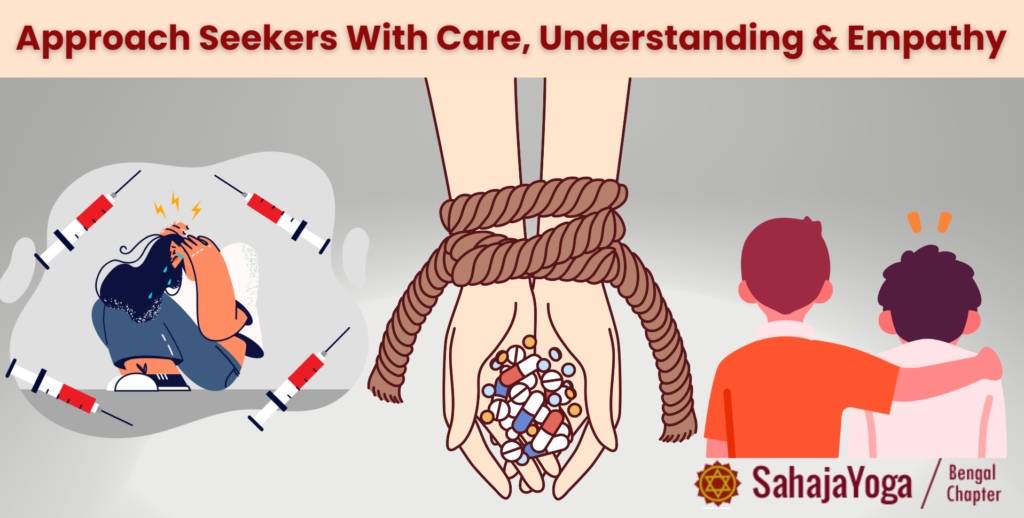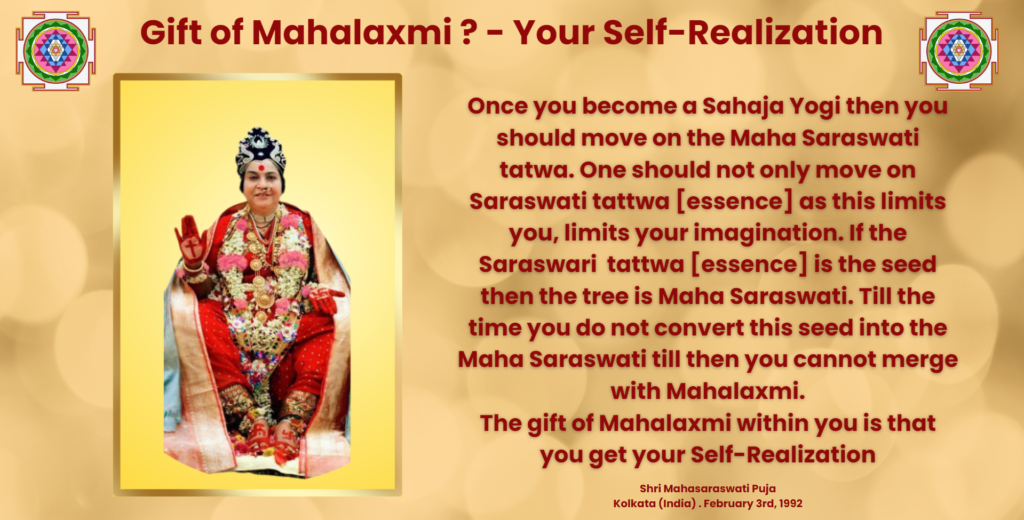Conversation with Dr. Talwar, Mumbai (India)
- Sahaja Yoga is described as a unique knowledge that Shri Mataji Nirmala Devi had been born with.
- Initially, Shri Mataji Nirmala Devi found it challenging to reveal this knowledge and sought ways to do so.
- On May 5th, 1970, Shri Mataji Nirmala Devi opened the seventh chakra as part of the process to reveal this knowledge.
- The concept of “brahmachaitanya” was previously unmanifested and was difficult to explain or comprehend.
- Previous incarnations attempted to share this knowledge with their followers, but due to its unmanifested nature, they were unable to fully realize or express it.
- Shri Mataji Nirmala Devi declared to be the incarnation of brahmachaitanya in its entirety, representing its manifestation.
- The unmanifested state of brahmachaitanya made it challenging for people to experience or understand it fully.
- With Shri Mataji Nirmala Devi‘s arrival, the unmanifested state has transformed into a manifested form, making it easier for people to comprehend and experience.
- Through Sahaja Yoga, individuals gradually elevate their consciousness, experience their Kundalini rising, and attain self realization.
- The concept of vibrations is emphasized in Sahaja Yoga, which was not discussed clearly in previous teachings due to the unmanifested nature of brahmachaitanya.
- Sahaja Yoga enables individuals to feel sensations on their senses and fingertips, providing a tangible experience of spiritual awakening.
- Shri Mataji Nirmala Devi brought the complete form of brahma-chaitanya from the unmanifested state to the manifested form.
- The manifestation of brahma-chaitanya is likened to a big vessel (ghata), with individuals being smaller vessels (kumbhas) within it.
- Shri Mataji Nirmala Devi describes Herself as maha-maya, indicating the ability to work slowly and gradually.
- Opening the seventh chakra enabled Shri Mataji Nirmala Devi to manage all the chakras and deities within individuals.
- The ability to feel vibrations related to different deities is presented as evidence of Shri Mataji Nirmala Devi’s identity as brahma-chaitanya.
- Although brahma-chaitanya and sada-shiva reside within Shri Mataji Nirmala Devi , their humanization makes it challenging for others to recognize.
- Sharing the truth about Shri Mataji Nirmala Devi‘s identity is deemed difficult for modern humans to comprehend and accept.
- Shri Mataji Nirmala Devi recalls an encounter where a boy mentioned that brahma-chaitanya is beyond feeling and non-feeling, prompting Shri Mataji to disclose the truth to a select few.
- Shri Mataji Nirmala Devi asserts that all religions are now integrated within the concept of brahma-chaitanya, allowing for a comprehensive understanding of various religious figures.
- Shri Mataji Nirmala Devi advises against discussing Sahaja Yogi’s identity with scientists, suggesting instead to attribute the knowledge to Shri Mataji Nirmala Devi.
- It is suggested to present Sahaja Yoga as a unique method facilitated by Shri Mataji Nirmala Devi , allowing individuals to witness the process of Kundalini rising firsthand.
- Historically, very few individuals have been able to give realization to others, with most achieving it through personal cleansing processes.
- The process of realization often involves deep purification and prayer, leading to the emergence of brahma-chaitanya within the individual.
- However, in the past, individuals who achieved realization often remained in a state of isolation, with no means of communication or collective expression.
- Shri Mataji Nirmala Devi compares the discovery of realization to discovering electricity, suggesting that without communication, others cannot benefit from it.
- While some past saints and prophets attained realization, their experiences remained individual rather than collective.
- The current era marks a shift towards collective realization, with t Shri Mataji Nirmala Devi indicating that the quality of individuals being developed now is akin to the disciples of past prophets.
- Those who choose to immerse themselves in the collective consciousness will be well-prepared, while those who remain outside will be left behind.
- Time is portrayed as a construct created by human habits, and Sahaja Yoga aims to help individuals transcend these habits and the bondage of time.
- The process of shedding habits takes time, and individuals must not justify their habits if they wish to overcome them.
- Sahaja Yoga is described as the last judgment, suggesting that it offers individuals the opportunity to achieve self-realization and transcendence.
- Despite encountering people behaving contrary to Sahaja Yoga revelations, it’s essential to persevere and not be discouraged.
- Stability in Sahaja Yoga comes from establishing the feeling or bhava for Shri Mataji Nirmala Devi in one’s heart, akin to acquiring habits.
- Detachment and chitta-nirodh (stopping one’s attention) aid in stabilizing the bhava within the heart.
- Conscious awareness of where one’s attention (chitta) is directed helps maintain balance and prevents it from straying.
- The convolutions in the brain caused by habits and sanskaras are gradually smoothed out through Sahaja Yoga practices, allowing for greater absorption of divinity.
- Scientists may find Sahaja Yoga concepts challenging to grasp, as they may be beyond conventional scientific explanations.
- The formation of kundalini shakti in the triangular bone area of the spine is described, along with the refraction effect of chaitanya within the brain.
- The parallelogram of forces theory from physics is applied metaphorically to explain how attention is pulled outward, leading to the formation of conditionings and ego.
- The mind, formed from reactions gathered from the outer world, is influenced by the left side (conditionings) and right side (ego).
- Action and reaction pass through both the agnya and vishuddhi chakras, influencing the ida and pingala nadis.
- The ida nadi’s overflow forms the super-ego, while the pingala nadi’s overflow creates the ego, with the agnya chakra positioned between them.
- When the kundalini enters the agnya chakra, it awakens Christ within, symbolized by the enlightenment of the agnya chakra and the simultaneous opening of the Sahasrara.
- The sudden opening of the Sahasrara is described as akin to telescopes aligning, accompanied by a burst of energy.
- With self-realization, deities are awakened, and chakras are nourished, leading to the integration of mind, body, and intellect.
- Before realization, attention is dispersed, but upon enlightenment, it is pulled inward to the Sahasrara, aligning with the kundalini’s path.
- However, due to habits, individuals may resist keeping their attention centered, analogous to resisting help while sailing.
- Keeping attention centered is crucial, as it allows left and right nadis to relax, chakras to further open, and kundalini fibres to rise.
- Attention then gains the quality of remaining centered, enabling individuals to perform tasks without attachment and return to the center afterward.
- Shri Mataji Nirmala Devi , however, takes on others’ problems and suffers on their behalf, illustrating a different dynamic.
- Sahaja yogis may also suffer to a lesser extent due to their connection with the Shri Mataji Nirmala Devi ‘s body.
- The study of the fifth dimension of matter, bioplasma, is mentioned as a right-sided activity, currently being explored in Russia.
- Each human being has their own aura, representing their changing gunas or qualities.
- Bandhans are given to auras to protect them, as only matter can have an aura, making it materialistic.
- The fifth dimension, microscopic or photographic, is related to aura, visible as lights in photographs.
- Brahma-chaitanya emits its own light, visible to some with a weak agnya chakra.
- Thoughtless awareness occurs when the kundalini crosses the agnya chakra, resulting in control and a state of doubtless awareness.
- Achieving this state requires collective effort, avoiding selfishness and escapism.
- The goal is not just to dissolve into the ocean but to become a cloud and nourish others with rainwater.
- Surrendering to the mother, acknowledging her role in all actions, is emphasized.
- Scientific minds should be introduced to Sahaja Yoga gradually, respecting their capacity to absorb knowledge.
- Encountering Maya while earning money is inevitable, but it should be done with the awareness that one is earning for the greater good.
- Newcomers to Sahaja Yoga often fare better when introduced by Sahaja yogis rather than directly by Shri Mataji Nirmala Devi .
- Everything in treatment depends on ichha or desire shakti, emphasizing the importance of having the right desires.
- Wrong desires lead to mechanical and hypocritical actions, while pure desires lead to genuine growth.
- Control over desire is essential for spiritual progress.
- Action energy or kriya shakti has physical and mental aspects.
- Physically, one must sit down and meditate to become thoughtless, while mentally, the mind should avoid nonsensical thoughts.
- Maintaining the attitude of surrender, acknowledging that “Mother, you are doing everything, I do nothing,” is crucial.
- Cleansing oneself before meditation is important, especially for left-sided individuals who tend to be more analytical.
- Arya-samaj followers, who are typically right-sided, should focus on bhakti (devotion) and bhajan (spiritual songs) to move towards the left side.
- Cleansing is done using mantras on the central chakras, with Mahakali and Mahasaraswati acting on both sides.
- Mantras are chanted to raise the kundalini and improve desire energy.
- Treatment of the left side involves raising the right hand and lowering it to the left, along with activating the right side using specific mantras.
- Control over the kundalini’s movement is essential to prevent imbalance and ensure spiritual progress.
- Without control, chanting mantras excessively can lead to imbalance and loss of spiritual focus.
Above is a short gist of partial speech of Shri Mataji.
Source: https://www.amruta.org/1987/02/27/conversation-with-dr-talwar/



